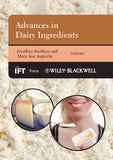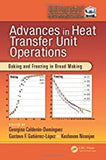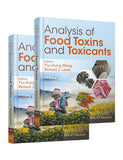How Flavor Works: The Science of Taste and Aroma by Nak-Eon Choi, Jung H. Han
How Flavor Works: The Science of Taste and Aroma
Description
Taste is the number one driving force in the decision to purchase a food product and food consumption is the most critical function for living organisms to obtain the energy and resources essential to their vitality. Flavor and aroma are therefore universally important concepts: intrinsic to human well-being and pleasure, and of huge significance for the multi-trillion dollar global food business.
How Flavor Works: the Science of Taste and Aroma offers a fascinating and accessible primer on the concepts of flavor science for all who have an interest in food and related topics. Professionals and students of food science and technology who do not already specialize in flavor science will find it a valuable reference on a topic crucial to how consumers perceive and enjoy food products. In this regard, it will also be of interest to product developers, marketers and food processors. Other readers with a professional (eg culinary and food service) or personal interest in food will also find the book interesting as it provides a user-friendly account of the mechanisms of flavor and aroma which will provide new insights into their craft.
Table of Contents
About the Authors xiii
1 What is Taste?
Four basic tastes, as proposed by Aristotle
Taste is complex
Most food ingredients are tasteless, odorless, and colorless
Variations in odor during fermentation and aging due to changes in molecular weight
2% is not a small amount
2 The Origins of Taste: Why do we Taste?
Sweetness is for identifying energy sources (Carbohydrates)
Umami is a tool used to search for proteins
Carbohydrates are for sweetness, proteins are for umami, but what are lipids for?
Saltiness: the ocean was the source of all life
The role of salt in cooking is not merely to provide saltiness
The contrast effect
The suppression effect
Acidity monitors the biological metabolism
Bitterness: if it’s bitter, spit it out!
Some people enjoy bitter tastes
The reason we consume caffeine despite its bitterness
The olfactory sense is the dominant sensory perception of animals
The search for food
Avoid danger!
Know who it is!
Find a mate!
References
3 Taste is General Science
Taste improves with harmonized combinations
The taste of meals = saltiness + umami + savory flavor
The taste of dessert (and fruit) = sweetness + sourness + sweet odor
Tastes influence odors
Food has to be dissolved for us to taste and chewed to enhance the taste
The main ingredients influence taste and odor
Sound has an influence on taste
Visuals, colors, and food styles
Why does color exist?
The basic structure of pigment: why are there no naturally blue foods?
Perception varies with individual differences and conditions
Differences due to age and sex
Individual variation is also significant
Differences due to race and history
The preference for smells is constantly changing
References
4 How do we Smell Odors?
Olfactory receptors are G-protein coupled receptors
G-Receptors differentiate isomers, resulting in different odors
G-Receptors perceive multiple chemical substances
G-Receptors work simply as on/off switches
Depending on the binding affinity to receptors, similar molecules can be recognized as completely different tastes and odors
The broad spectrum of the olfactory sense
The transduction of sensory signals
Olfactory fatigue is also a functional activity for life
The recognition and integration of perceptions
Parts of the brain
Continuous circulations in the loop
G-Receptors can perceive light
Understanding G-receptors can provide many answers
Pheromones are not mysterious substances
References
5 What Creates Smell?
Odorous molecules are mainly created by plants
Why do plants produce aroma compounds?
Attracting bacteria, insects, and animals
As a defensive mechanism
Attacking tools
Coincidental byproducts
Animals generally smell odorants, not produce them
Animal-origin raw materials
Unconditional surrender to pheromones
Is body odor a coincidental byproduct?
Most flavors that we enjoy are created by cooking
Flavor production by enzymatic or microbial fermentations
Flavor production by heat processes
Flavor production by pyrolysis: smoke flavor
Compound flavor: creation of new flavors by mixing various odors
References
6 Technological Advancements Brought about by the Love of Flavors
Why do people combine flavors?
How many flavors are there in the world and how many ingredients are required to make all of these flavors?
How many odorous chemicals are needed to create a tomato flavor?
Perfumers and flavorists create flavors
Olfactory training: flavorists must first distinguish odorous chemicals before creating compound flavors
Compounding flavors: aromas are completed through imagination
To become a perfumer, a heavy smoking habit and age do not matter
The important factor is harmony
Applications of compound flavors
Types of odorants
Synthetic flavors versus natural flavors: which is safer?
Advantages and limitations of natural flavors
Advantages and limitations of compound flavors
References
7 How Flavors Influence us
Brain development began with the olfactory sense
The human olfactory sense is less sensitive and inarticulate
Humans’ sense of smell has degenerated greatly
Proust phenomenon: odor-evoked autobiographical memory
Sensorial preference changes destinies
Do silkworms only eat mulberry leaves?
Humans live with smells
Stage of development
What happens if you can no longer feel taste or smell?
Are humans free from pheromones
The healing power of aromas
Aromatherapy
Aromachology
Phytoncide
Is geosmin foul or pleasant?
Multiple chemical sensitivity (mcs): there are people who are really intolerant to odorous chemicals
References
8 Taste is Regulated by Flavor, and Flavor is Regulated by the Brain
The sense of smell is directly connected to the imbic system, in other words, to survival and emotion
Neuroplasticity in the brain
Is synesthesia a malfunction or a blessing?
Taste is a typical phenomenon of synesthesia and neuroplasticity
Orbitofrontal cortex: where sight, taste, smell, and touch meet
Taste is a part of pleasure, and that pleasure becomes a part of taste
Experience affects taste: familiar foods are preferred
The feeling of disgust can be acquired through learning
Taste is affected by temperature
Price: expectation affects the taste
Prejudices are effective at distorting perceived senses
Even the data from an expert research firm cannot promise success in sales
Sensorial perception is an illusion
Taste and aroma do not exist
A good product image makes it taste better
References
9 The Future of Taste and Aroma
Raw ingredient resources gradually become simplified and their original aromas disappear
More scientific technologies will be incorporated into the culinary arts
What is the difference between cooking and the processing of foods?
Aroma-releasing television or movies
Is the taste of processed foods inferior to that of natural foods?
Is it true that obsessions with flavors and seasonings have decreased?
Do technological developments of taste modifications induce obesity or become a key solution to the problem?
Technology of satiety: technology of cognitive science for taste and olfactory senses is the technology of the future
Satiety control
The era of supernormal stimuli
References
10 Concluding Remarks
References
Index
Author Information
Nak-Eon Choi is Research Director at Sias Co, Ltd, Seoul, South Korea
Jung H. Han, PhD CFS is an Adjunct Associate Professor in the Department of Food Science and Human Nutrition at
the University of Illinois at Urbana/Champaign, USA
Related Products
-
A Textbook of Modern Toxicology,...
8,942.00
10,520.00 -
Advances in Dairy Ingredients By...
15,497.00
18,231.00 -
Advances in Heat Transfer Unit O...
15,988.00
18,810.00 -
Analysis of Food Toxins and Toxi...
18,900.00
21,479.00 -
Analysis of Foods and Beverages ...
5,725.00
-
Analysis of Pesticides in Food a...
2,895.00
13,068.00
- Architecture & Construction Management Books
- Biochemistry, Bioengineering and Biotechnology Books
- Books on Analytical Techniques, GC MS, LC, TLC, HPLC, NMR Spectroscopy
- Books on Water and Wastewater Treatment, Analysis Water Treatment Plants
- Chemical Technology, Organic Chemistry, Chemical Synthesis and Chemical Analysis Books
- Cosmetics Science, Cosmetics Formulations, Manufacture and their Analysis Books
- Drugs and Pharma Science Books
- Essential Oils, their Analysis, Natural Products Extraction, Distillation , Isolates Related Books
- Flavor Science, Flavor Analysis, Flavor Creation, Food Flavors Books
- Food Science and Technology, Baking , Food Ingredients , Food Quality , Food Regulations
- Formulations of Perfumes for Agarbatti, Air Freshners, Soaps & Detergents, Fabric Softeners , French style Perfumes, Attars , OUD, Fine Fragrances
- Fragrances, Scents, Attars , Perfumery and Aroma Chemicals Books
- Herbal, Ayurvedic, Medicinal Plants and Aromatic Plants Books
- Law Books
- Major Reference Works (MRWS) Sets - MultiVolume Sets
- Medical Books
- Medical Journals Wolters Kluwer | Medknow India
- NEW ARRIVALS
- Perfumer's Resources
- Special Indian Reprint !


















